India’s middle class is no longer an emerging economic force, it’s a defining one. Over the last decade, this segment has rapidly grown not just in size but in aspiration, consumption, and digital adoption. For brands in the consumer electronics space, this shift signals more than a demographic milestone, it represents a transformative market opportunity.
As incomes rise, access improves, and lifestyles evolve, the way Indian consumers engage with technology is undergoing a major upgrade. For manufacturers, retailers, and solution providers in the electronics and appliances sector, the big question is: Are you aligned with the aspirations of India’s new middle class?
Let’s explore what this booming segment means for the future of consumer electronics in India.
A Growing Middle Class = A Growing Market for Electronics
India’s middle class is projected to reach 700 million people by 2030, up from around 350 million today. This segment is expected to contribute nearly 75% of India’s consumer spending within the next five years. That shift brings with it a marked change in priorities, from price sensitivity to value sensitivity.
This consumer group is:
- Digitally active
- Aspirational and brand-conscious
- Willing to invest in tech that improves convenience and lifestyle
- Open to smart, energy-efficient, and aesthetically appealing products
For electronics brands, this translates to a demand surge across multiple categories, including:
- Smart TVs and entertainment systems
- Smartphones and accessories
- Home appliances (ACs, refrigerators, washing machines)
- Personal gadgets (wearables, TWS earbuds, tablets)
- Smart home products (lighting, security systems, automation tools)
Beyond Metros: The Rise of Bharat
While Tier I cities remain key markets, the biggest growth in the electronics space is coming from Tier II and Tier III cities, and even rural belts.
These emerging urban centers now have:
- Improved infrastructure
- Faster internet and 4G/5G penetration
- Growing digital literacy
- Expanding retail ecosystems (both online and offline)
This decentralization of demand is vital. For electronics brands, it means rethinking distribution, localizing product messaging, and developing after-sales support systems tailored for these regions. Brands that once focused on Delhi, Mumbai, and Bangalore are now strategizing around Lucknow, Coimbatore, Indore, Bhubaneswar, and Guwahati.
The playing field has widened, and with it, so has the opportunity.
Value Matters, but So Does Aspiration
India’s middle class has traditionally been price-conscious. But the new middle class is more nuanced. While affordability remains important, today’s consumer also weighs:
- Design and aesthetics
- Energy efficiency and sustainability
- Brand trust and post-sale service
- Tech specifications and compatibility
For example, a buyer in Surat might still want a good deal, but now they’re comparing 4K vs QLED panels, voice-assistant integration, or inverter tech in washing machines. This is no longer just about entry-level products. It’s about smart value, and brands must design accordingly.
Entry-level SKUs are still critical, but so is offering mid-premium and feature-rich variants for those willing to stretch their budgets for quality.
The brands Currently Should Take OmniChannel Approach
India’s middle class doesn’t shop the way it used to. Smartphones are the new storefronts. Today, over 50% of electronics sales in Tier II/III cities happen online. But offline retail is far from obsolete, it plays a crucial role in product discovery, demos, and post-sale engagement.
This gives rise to a hybrid, omni-channel approach:
- Online-first brands are investing in experience centers.
- Traditional brands are digitizing their storefronts.
- D2C channels are becoming key for brand storytelling.
For B2B players, whether manufacturers, solution providers, or tech enablers, the shift means aligning with partners who are equally flexible and channel-agnostic.
Retailers are now looking for products that offer online reach and in-store appeal. Packaging, warranty programs, compatibility with online ratings/reviews, all of these are influencing what gets picked up by trade buyers.
Premiumisation on the Horizon
While mass-market demand will always be India’s volume backbone, premiumisation is no longer restricted to niche audiences.
An increasing number of consumers are looking at:
- Smart refrigerators with AI features
- Convertible ACs
- Multi-device ecosystems (smartphones + wearables + smartwatches)
- Voice-controlled and app-enabled appliances
This behavior opens up space for:
- Higher margin products
- Cross-category bundling
- Brand ecosystems that tie users into long-term tech journeys
For B2B players, this means an opportunity to position higher-end product lines for retailers, and pitch bundled offerings that create value-chains rather than standalone items.
Support, Services & Warranty: The Hidden Differentiators
The rising middle class is digitally connected, vocal, and expects support, fast. Product failure, delayed service, or hard-to-access warranty programs can derail brand trust faster than ever. As a result, the after-sales experience is becoming a key brand differentiator.
Retailers and distributors are prioritizing brands that offer:
- Pan-India service networks
- App-based service requests
- Transparent warranty policies
- Easy availability of spares/accessories
For exhibitors and manufacturers, there’s a growing need to factor in not just product design, but service strategy. This could be a strong area of collaboration with logistics, software, and after-market solution providers.
The Competitive Edge: Agility, Localization & Innovation
To stay competitive in this shifting landscape, brands must be:
- Agile in responding to demand patterns and pricing trends
- Localized in marketing, packaging, and even feature sets
- Innovative in product design, function, and compatibility
India’s middle class is not a static block, it’s a dynamic, growing, and diversifying force. Their preferences evolve rapidly. Keeping up means shorter product development cycles, smarter R&D investments, and constant market listening.
Final Thought
India’s growing middle class is not only expanding in size but also evolving in behavior, demanding smarter, more connected, and aspirational consumer electronics. For brands, this shift presents both an opportunity and a challenge: to innovate not just in products, but in how they reach, engage, and support this dynamic audience.
Looking ahead, the future will belong to brands that build ecosystems, prioritize user experience, and offer flexibility across digital and physical retail. As competition intensifies, differentiation will hinge on how well brands anticipate emerging needs, design for regional nuances, and invest in long-term customer relationships.
For businesses in the consumer electronics and appliance ecosystem, this is a defining moment. And platforms that bring together manufacturers, innovators, channel partners, and market enablers provide the ideal launchpad. Participating in such an ecosystem isn’t just about visibility, it’s about being part of the conversation shaping what’s next.












